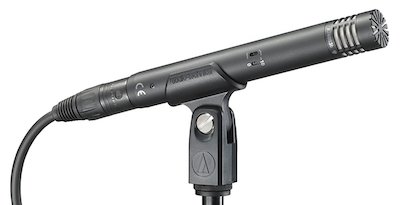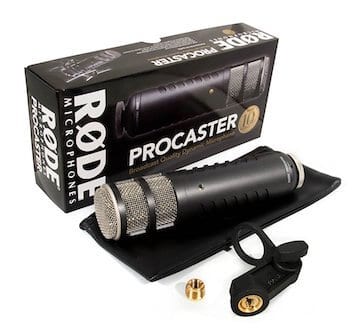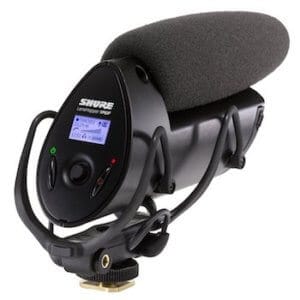Deciding what the best microphone for YouTube is will largely depend on the type or style of videos you are doing. In many cases, you will want more than one microphone so that you can use the one that fits your situation best.
If you are doing screen recordings or voiceovers after you record, a USB or XLR studio mic would work best.
Lavalier microphones are great in a lot of situations where you don’t want to have to worry about how close to the mic you are – just clip them on and start recording.
Shotgun mics are excellent for run-and-gun style videos, vlogging, and sit-down interview-style shots.
Because there are many different types of videos, and different microphones that work well for recording them, we’ve highlighted our favorite YouTube mics by category so you can easily find what will work best.
Quick Overview: Best Microphones for YouTube Videos
| IMAGE | PRODUCT | |
|---|---|---|
 | Best Studio Mic Rode NT-USB
| VIEW ON AMAZON → |
 | Blue Yeti
| VIEW ON AMAZON → |
 | Audio-Technica AT2035
| VIEW ON AMAZON → |
 | Best Lavalier Mic Rode SmartLav+
| VIEW ON AMAZON → |
 | Best Shotgun Mic Rode VideoMic Pro+
| VIEW ON AMAZON → |
 | Best Small Diaphragm Condenser Mic Audio-Technica AT4053B
| VIEW ON AMAZON → |
Best Studio Mics For YouTube
We have separate articles (USB & XLR) dedicated to studio mics designed for voice recording (perfect for voiceovers). I strongly recommend getting a desktop-mounted boom arm to pair with any of these mics.
Below are a few of our top picks:
USB Microphones
USB microphones are definitely the easiest to set up and use, but you are limited in your ability to easily upgrade and expand your audio quality over time.
Rode NT-USB
The Rode NT-USB is a studio cardioid condenser microphone with a USB connection for easy plug-n-play use. The included tripod works well to keep noise levels down, but it can always be improved by using an external shock mount.
Sound quality is excellent and easily one of the best YouTube mics under $200. There is a headphone jack with volume control as well as a mix control dial so you can blend computer audio with your voice. It is lacking onboard gain control, so you’ll have to set the input volume on your computer.
Blue Yeti
It’s no surprise that the Blue Yeti is a favorite among YouTubers. It offers great sound quality and a ton of features for the price.
There are 3 condenser mic capsules, allowing you to choose from 4 different pickup patterns. Most people will probably just need the cardioid pattern for voiceovers, but having the ability to turn it into a conference or interview mic makes it more than worth its price (and the Yeti is frequently discounted under $100 during holiday sales).
It also includes a mute button (very useful!), gain control, headphone jack (with volume dial), and a decent stand.
You’ll find they offer the Yeti in a bunch of different colors too.
Blue Snowball
The Blue Snowball is the little brother of the Yeti and is an awesome USB YouTube mic. There are actually two different models: Blue Snowball and Blue Snowball iCE.
The first one (Blue Snowball) has 2 mic capsules, allowing omnidirectional (all directions) and cardioid (perfect for voice recording) pickup patterns, an adjustable-height stand, and a slightly better build quality.
The Snowball iCE has a single cardioid capsule and no height adjustments.
XLR Microphones
When you’re ready to really improve your YouTube audio quality, you’ll want to get an XLR microphone. That means you’ll also need a USB audio interface to connect it to your computer (our favorite: Focusrite Scarlett 2i2). You can always add microphone preamps and other equipment down the line as well.
Audio-Technica AT2035
I love that the Audio-Technica AT2035 comes with a shock mount. You’ll need a boom arm to mount it, but your audio quality will be greatly improved and you won’t have to purchase the mount separately. The mic also has an 80Hz high-pass filter that will help eliminate really low sounds like computer fans, heaters, and other ambient noise.
This is a condenser microphone, which means you’ll need to provide it phantom power, but you shouldn’t need a whole lot of gain.
Rode Procaster
The Rode Procaster definitely punches above its price point. It has an internal pop filter to reduce p-pops and an internal shock mount to reduce vibrations and handling noise. You can also get the Rode PSM1 shock mount to further isolate the mic. I highly recommend the shock mount as the included mount is somewhat weak and made of plastic, plus it will be much easier to adjust the Procaster into the right position.
It’s an end-address dynamic cardioid mic that needs a decent amount of gain. The easiest way to give it an extra boost is to use the Cloudlifter CL-1 or a separate pre-amp like the DBX286s, but I use it straight into a Zoom H5 with the gain set to about 6 without any issues.
Shure SM7B
If you want one of the best dynamic studio mics for your YouTube videos, the Shure SM7B is amazing. You won’t need a separate shock mount or pop filter, making its value go up a bit. You also get a thicker removable windscreen should you need it.
That said, you’ll definitely want a Cloudlifter for this mic as it needs a bunch of gain.
Best Lavalier Mics For YouTube
Lavalier mics are great because they are small and easy to travel with. They won’t get in the way of your video and simply clip or stick to your shirt.
You’ll need to pay attention to the type of connector they use as some are designed for smartphones (TRRS jack) and some for DSLRs and portable recorders (using either TRS or XLR connections). You can always get adapters, but I just wanted you to be aware that the connections vary.
Feel free to take a look at our full list of recommended lav mics as well.
Rode SmartLav+
If you want something you can just plug into your phone to get excellent audio, the Rode SmartLav+ is a popular choice. It uses a TRRS connection (that’s what your phone uses) but you can always get the Rode SC3 adapter if you want to use it with a recorder or camera.
This is a great choice if you don’t want to spend several hundred dollars on a professional-level lavalier mic.
Rode RodeLink Filmmaker Kit
The RodeLink Filmmaker Kit is a wireless lavalier kit that is designed to be connected to a DSLR camera or digital recorder. You get a high-quality lav mic that connects to a digital transmitter and a digital receiver. The wireless connection works from very far away unless you’re in a crowded event like a trade show with tons of other wireless devices nearby.
Audio-Technica ATR3350iS
On a budget? The Audio-Technica ATR3350iS is a killer deal. It has a long (nearly 20′) cable and comes with an adapter so you can use it with a smartphone or a camera. I have used this mic in fairly noisy environments and it barely picked up background sounds. Highly recommended for those that want a cheaper option.
Best Shotgun Mics For YouTube
A shotgun mic for YouTube will ideally attach to the shoe on your camera and provide you the flexibility to also use off-camera should you want to use it for interviews or other similar tasks.
We have a detailed post highlighting the best on-camera shotgun mics if you want to see more recommendations at different price points.
Rode VideoMic Pro+
The Rode VideoMic Pro+ just came out in August of 2017. It improved on the VideoMic Pro (no plus) with a ton of new and useful features.
Some of my favorites are auto power on/off, removable cable, safety channel, and rechargeable lithium battery.
It’s not cheap, but this is an awesome little shotgun mic.
Rode has a whole line of VideoMic’s should this one be a little out of reach too.
Shure VP83F
What’s cool about the Shure VP83F is that it includes a MicroSD card slot so you can use this mic without a camera if needed. It also has extremely fine gain control so you can adjust the pickup volume quickly depending on your situation.
Best Small Diaphragm Condenser Mics For YouTube
Shotgun mics tend to have trouble indoors if there is a lot of echo. If you’re regularly recording in an environment like this, you’ll want to consider getting a small diaphragm condenser mic with either a hypercardioid or supercardioid pickup pattern.
Audio-Technica AT4053B
The Audio-Technica AT4053B is a hypercardioid boom mic that is highly recommended for indoor dialogue (voice). The mic capsule is interchangeable, so if you need a different pickup pattern you can simply swap the heads.
Oktava MK-012
A less expensive option is the Oktava MK-012. This is also a modular mic that comes with hypercardioid, cardioid, and omnidirectional capsules – all in one kit! This is what I would start with.
Be careful when you’re shopping around because the MK-012 model name applies to several different capsules. At the very least, you’ll want the hypercardioid version.
Which Microphones Do YouTubers Use?
The short answer is all of the above. But let’s take a look at what microphones popular YouTube creators use:
Casey Neistat (@CaseyNeistat)
- Rode VideoMic Pro (on-camera shotgun)
- Shure VP83 (backup to above mic)
Marques Brownlee (@MKBHD)
- Blue Yeti
- Sennheiser MKH416 (shotgun)
- Schoeps MK41 (supercardioid set)
Kraig Adams (@Kaaadams)
- Rode VideoMic Pro+ (on-camera shotgun)
- Rode NT-USB
- Sennheiser AVX ME2 Lavalier Kit (pro-level wireless lavalier for DSLR)
David Rock aka drock (@davidrocknyc)
- Rode VideoMic GO (on-camera shotgun)
- Sennheiser AVX ME2 Lavalier Kit (pro-level wireless lavalier for DSLR)
- Sennheiser EW 112P G3-A (wireless lavalier kit)
Roberto Blake (@robertoblake)
- Rode VideoMic Pro (on-camera shotgun)
- Sennheiser MKE 440 (on-camera shotgun, dual capsules)
- Rode RodeLink Filmmaker Kit (wireless lav for DSLR)
- Rode VideoMicro (on-camera shotgun, tiny & budget-friendly)
- Audio-Technica ATR2100-USB (USB & XLR, excellent for the price)
- Blue Yeti













